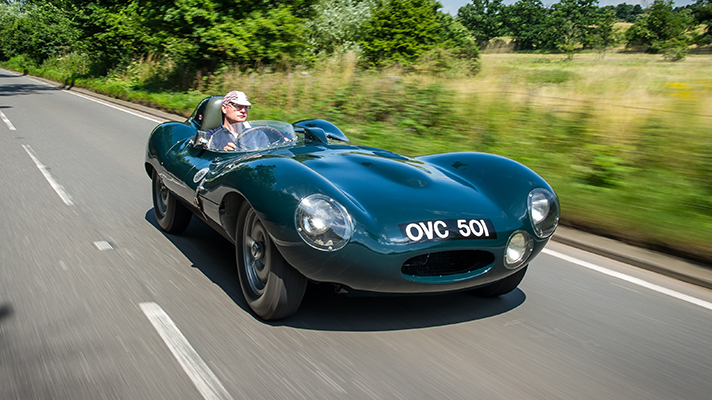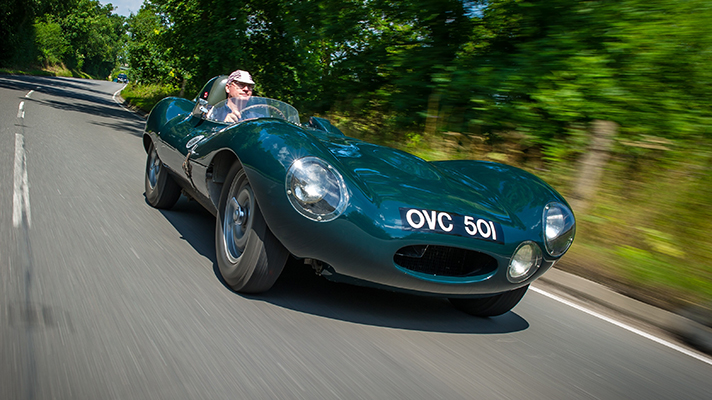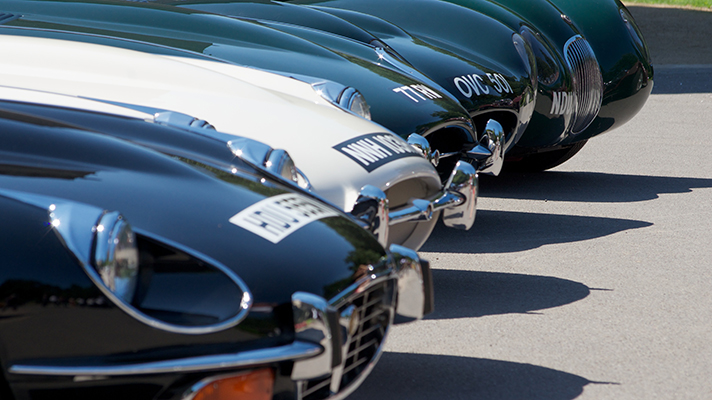
Top Gear drives the Jaguar D-Type
There are two kinds of sweat. Nervous sweat. And hot sweat. I've just learned how it feels to have both kinds multiplied together. Sweat squared.
This boil-in-the-bag experience comes in the notoriously high-temperature cockpit of a Jaguar D-Type, on the hottest day of the year. It's 33 degrees outside before we fire the engine. That done, gales of heat are rejected by the big old racing straight-six, to flow back over the tiny windscreen making a furnace for my face. My left leg is torched by the transmission tunnel.
And the nerves. Oh gosh the nerves. This is such a precious car. The 1954 Jaguar D-Type, chassis number one. The prototype of the car that won Le Mans three times.
We mentioned yesterday that Top Gear had driven in the celebration convoy of historic Jags to the opening of the new Jaguar Gallery at the Coventry Museum of Transport.
So I've been offered the open goal of driving this terrifyingly valuable Jaguar up the chuff of another terrifyingly valuable Jaguar. Hey ho. Park those thoughts and enjoy this utterly intoxicating, wonderful car.
This was the machine that the company's test driver Norman Dewis drove down from the factory to Le Mans test weekend in 1954. Here he is today, a sprightly feller in cowboy boots and bootlace tie, days away from his 93rd birthday. He tells me as he shows me the car that once he'd arrived at the circuit that spring day in '54, he took three seconds off the lap record.
Today in traffic it's a bit of a sod to get rolling, as it's still on its long Le Mans gearing and has a sharp racing clutch. Dewis tells me that if I need to slow down I should just freewheel along, then let the thing bite and shove away again. Don't slip it, he says. Duly noted.
But once you're away, it's just a delight. The 3.4-litre XK twin-cam engine was an advanced thing: all-aluminium for light weight, dry sump to lower the bonnet and avoid oil surge in corners, triple Webers for stout and instant fuelling. It pulls decently even from 1500rpm. But it fluffs a bit if you're too gentle with the throttle. Use more pedal and it co-operates. Then towards 3000rpm the lovely resonant exhaust noise hardens and the forward motion picks up distinctly. The red-line is well beyond 6000rpm, but I don't get there even though it's obviously wanting me to. So we've got heaps of torque and 245 bhp in a car of Elise weight. Tasty.
In the convoy, the going is all frustratingly sedate, despite the fact that our police outriders said we could have a bit of fun. Everyone was following the slow-moving film crew. Never mind. I'd taken the precaution of going for a couple of practice drives beforehand. Get some mph into it, and this car really finds its rhythm.
The steering, unpowered of course, isn't as heavy as you'd expect, even at walking speed. Get a bit of pace under the tyres and it lightens up nicely. It isn't perfectly sharp, but has a lovely organic breathing motion as it goes over the undulations. That's what old cars do. You can place it very accurately, partly because it's rack and pinion. It isn't wandery or vague.
Top Gear
Newsletter
Thank you for subscribing to our newsletter. Look out for your regular round-up of news, reviews and offers in your inbox.
Get all the latest news, reviews and exclusives, direct to your inbox.
The brakes are not at all like 1954 brakes. They work. They knock off speed sharply, and they pull you up straight too. Jaguar was the first to use discs, on the C-type, and it helped them win Le Mans, not necessarily because braking power was much more than the opposition, but because full-stops were available at each corner they came to. Not like the awful fade of the rival drums. So I know that if this convoy stops, I can stop too. A relief.
Which leaves me plenty of brain-space for gearshifts. The four-speed lever's movements are mechanical and brief, and need a solid shove to ker-lunk home. You've got to have well-ordered timing of throttle and clutch. That learnt, it's just brilliant.
The smell and touch of history is all over this car. The cracked and gnarled leather pads on which you sit. The years of shine on the aluminium gearknob and wooden steering wheel rim. The smell of period oils. The chipped paint of the riveted aluminium and magnesium cockpit - it's like a world war two plane in here.
Literally so, as Dewis explains. The preceding C-type was a solid mechanical package. Its powertrain was durable, and the brakes were an advantage rivals still didn't have. For the new D-type to move things to the next step, it had an aircraft-type shape and construction.
"It was done on aircraft principles by Malcolm Sayer, who'd arrived from the Bristol Aircraft Company. I worked with him in the wind tunnel. We had tufts of wool all over the car - properly arranged mind, not just stuck on anywhere. He'd look at one side and I'd check the other. You could see the turbulence because in those places they'd be blown forwards.
"The whole thing was built like an aircraft, too," he says. The C-type had a steel tube construction with a non-stressed skin. Not the D. "It had a central riveted monocoque, with the engine frame fixed to the front bulkhead. And of course we bolted the front suspension to that. It took the Formula One boys a couple of years to cotton on."
Dewis was the development driver for all the Jaguars from the C-Type to the XJ-S and XJ40-series XJ. He'd been at Armstrong Siddeley before that, and remembers how Coventry was once the greatest motor city in Europe, home to dozens of now-defunct makes. Which is what makes him, locally born and raised, such a supporter of the Coventry Transport Museum.
So can he pick his favourite Jaguar? He recalls the later low-drag series of D-Types, the long-nose cars which also had a wraparound screen and integrated tail fin. He was racing at Le Mans in 1955 and got 192mph on the Mulsanne straight.
He nods to the E-Type too. Remember it was he who drove the first roadster to its sensational Geneva show debut in 1961. That car, registration 77 RW, is also in our convoy. He did it - Coventry to Geneva - in 11 hours including the ferry crossing. Just try that now.
But then he says his true favourite was the XJ13. This was the stillborn mid-engined V12 racer. They only built one, in 1966, and it was stymied by foot-shuffling management in the BMC merger, not to mention the arrival of the Ford GT40 as opposition. But, says Dewis, "It had the lowest drag coefficient of any car."
It was put in storage, but in 1971 Jaguar wanted a publicity film of this V12 machine at speed, to help launch the V12 E-type. Dewis was driving at MIRA's high-speed track when a tyre blew. "I rolled it... in a big way. He he. I was OK. I'd rolled a C-type and a D-type. Always got out and went back to work the next morning."
A drive of the first D-Type, and the man here before us. What an afternoon. We are not worthy.
Trending this week
- Car Review
BMW 1 Series
- Top Gear's Top 9
Nine dreadful bits of 'homeware' made by carmakers










